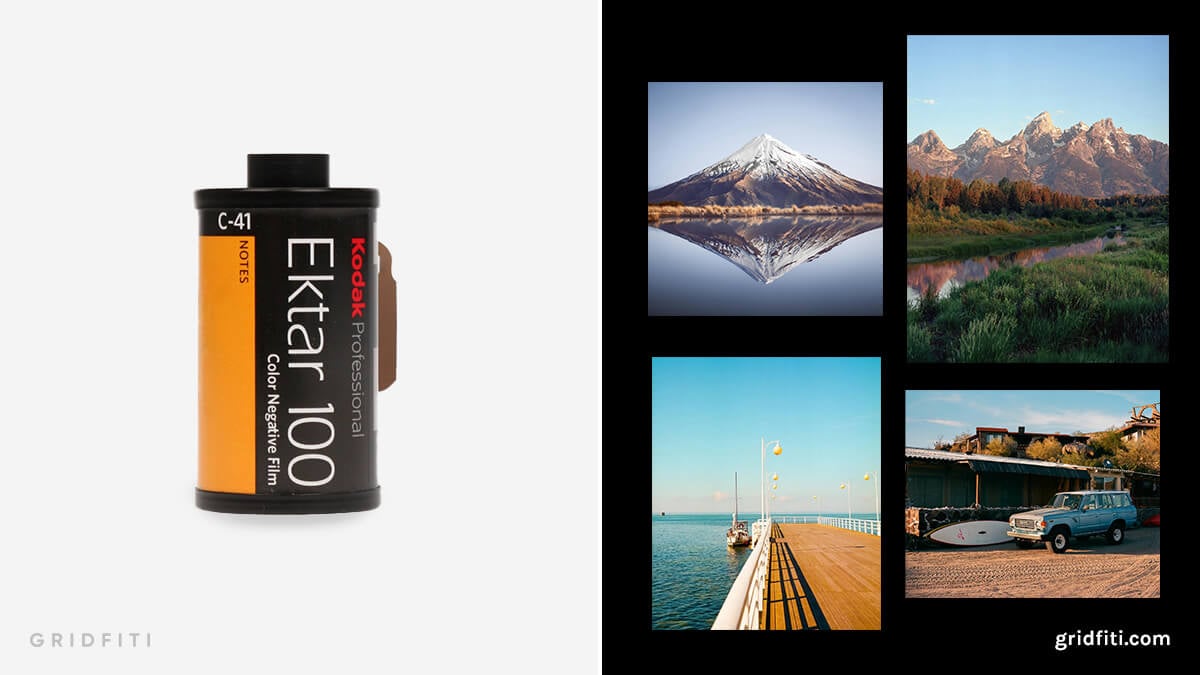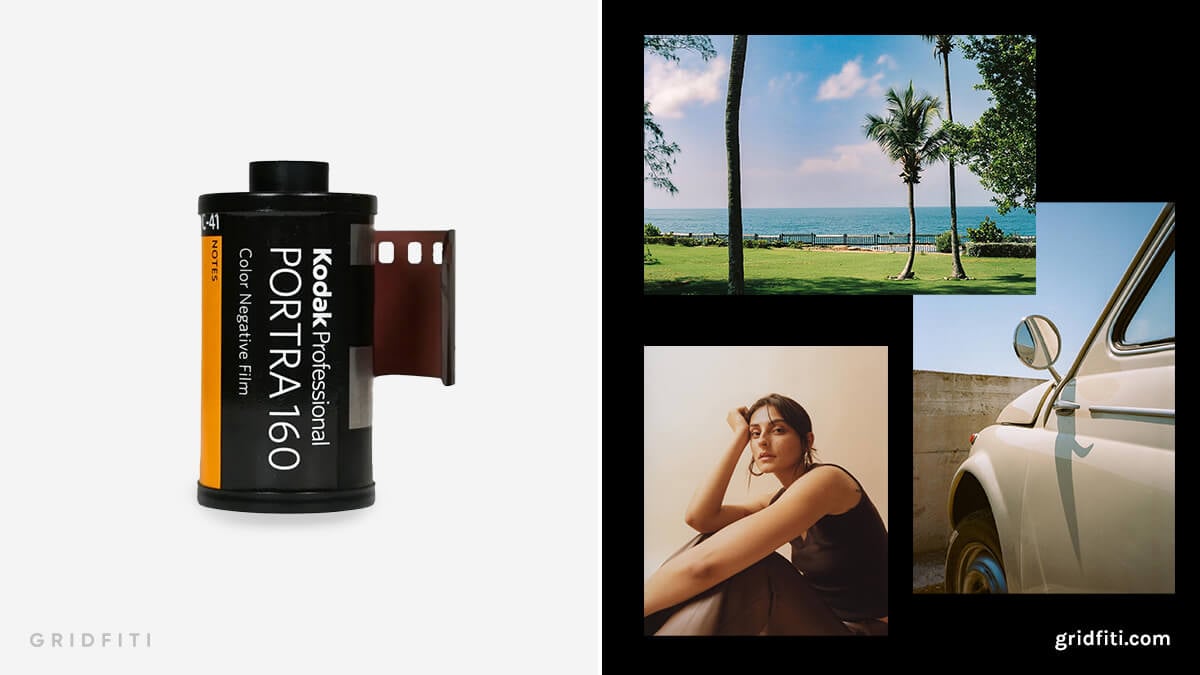In the mass hysteria that is film photography in the modern age, it’s easy to get caught up in the plethora of film stocks that are out there. Where does one even begin? Focusing in on one brand of film such as Kodak even comes with its own struggle!
Two film stocks that come to mind for starter film photographers and pros alike are the coveted Kodak Ektar and Kodak Portra. Two films intertwined in their use cases but also used across scenarios. With Portra being the most popular film stock out there right now and Ektar being a prosumer level film stock – we’re here to dive deep into the differences between the two. Check out our comparison of Ektar 100 vs. Portra 400 & 160!
Want more film photography tips? Join our mailing list, and check out our several other film photography guides.
First off, why are Portra and Ektar so popular?
Kodak is a name synonymous with film photography. With a name as renowned as this, it’s often the first go-to film brand of choice for a lot of photographers. They create films suitable for a massive variety of scenarios and use cases.
This is where Kodak’s Portra and Ektar lines come in – both considered professional films and used across a variety of settings. Portra and its wide exposure latitude and wide availability make it a great choice for novice film photographers, while Ektar’s 100 speed caters to the shooter who is looking for fine grain and exceptional color reproduction.
Nonetheless, we come at a crossroads: between Ektar 100 and Portra 160 & 400, which is best for you? Let’s jump in!
Difference between film speed / ISO
To quickly recap, the number at the end of these film stock names refers to the film’s speed or ISO. This number is telling you the film stock’s sensitivity to light.
The higher the speed, the more hungry it is for light – and that’s reflected in the brightness and highlights of photos. The lower the film speed, the less it’s able to absorb light – resulting in more pronounced shadows when light isn’t abundant.
Additionally, higher film speeds also bring more noticeable grain to your photos, whereas lower speeds will produce finer grain, and retain image details and information better.
Kodak Ektar 100 vs. Portra 160 & Portra 400
Kodak Ektar 100
Kodak Ektar 100 is a high-end, prosumer film offering from Kodak. The feature that strikes right away with this film is its low film speed of 100, which achieves extremely fine grain and little to no detail loss in photos.
This level of film speed does come with work though – Ektar’s low exposure latitude of a 100 speed film means you’d just need to take your time with metering and exposure properly.
When you get the exposure right though, does this film ever come to life! Ektar 100 is a great film for landscapes or anything needing heavy detail. The film is also a go-to for professionals in a studio setting where light can be controlled through flash and ambient methods.
Ektar 100’s colors are that of dreams – known widely for its great vibrancy coupled with deep shadows and contrast, even sporting a slight magenta cast. It takes real life colors and adds its own magical enhancements to it through its emulsion. You’ll be thankful you packed it for adventures that have lots of light and color.
Kodak Ektar 100 is developed through C-41 chemistry and comes in 35mm, medium format and large format.
Check out Kodak Ektar 100:
- Ektar 100 35mm Film: Get it on Amazon | Get it on Moment
- Ektar 100 Medium Format (120) Film: Get it on Amazon | Get it on Moment
- Ektar 100 Large Format Film: Get it on Amazon | Get it on Moment
 Photos by @stephenmilnerphotography, @film.lane, @woofermagazine, @johnprolly
Photos by @stephenmilnerphotography, @film.lane, @woofermagazine, @johnprolly
Kodak Portra 160
Portra: we’ve all heard of this film stock line by now. An incredible professional level film used by all, and made famous for its colors and versatility.
This versatility is due to Portra’s famous exposure latitude. What’s this, you ask? Exposure latitude refers to how well a film stock is able to capture colors and information when slightly overexposed or underexposed. Photographers will purposely do this with Portra to get slightly brighter images, or darker and higher contrast images. The color reproduction on Portra leans towards warmer tones, and has great exposure for skin tones.
All Portra films are color negative and developed through C-41 chemistry and available in 35mm, 120 medium format, and large format. Unfortunately, the price of Portra is on the rise, but this comes at the exchange for premium quality film and photos. If those Portra prices are looking steep – check out these Portra alternatives.
Check out Kodak Portra 160:
- Portra 160 35mm Film: Get it on Amazon | Get it on Moment
- Portra 160 Medium Format (120) Film: Get it on Amazon | Get it on Moment
- Portra 160 Large Format Film: Get it on Amazon
 Photos by @jpegans, @andrewethomp, @mrjoelphoto
Photos by @jpegans, @andrewethomp, @mrjoelphoto
Kodak Portra 400
Kodak Portra 400 sits at the midpoint between its other 160 and 800 speed offerings. Portra 400 is meant to be versatile in lighting settings to capture subjects from landscapes, to portraits, and everything in between.
Portra 400’s grain is a bit more noticeable than Portra 160 and Ektar 100, but this will show in photos taken in less light abundant environments – however, if you get the exposure right, you can achieve a fine grain look. Nonetheless, the same color reproduction, exposure latitude, and warm tones of Portra 160 are evident in this higher speed iteration.
The film is made in 35mm, medium format and large format offerings, and is also developed through C-41 chemistry!
Looking for the Portra 400 look, but for your digital photography? Check out these Portra 400 Lightroom Presets.
Check out Kodak Portra 400:
- Portra 400 35mm Film: Get it on Amazon | Get it on Moment
- Portra 400 Medium Format (120) Film: Get it on Amazon | Get it on Moment
- Portra 400 Large Format Film: Get it on Amazon | Get it on Moment
 Photos by @2071photo, @__marcodistefano
Photos by @2071photo, @__marcodistefano
What are your thoughts on Ektar 100 vs. Portra? Which will you choose to go out and shoot with? Let us know in the comments below and tag us in your Kodak photos on Instagram @gridfiti
Gridfiti is supported by its audience – when you buy something using the retail links in our posts, we may earn a small commission at no additional cost to you. Read more about our affiliate disclaimer.